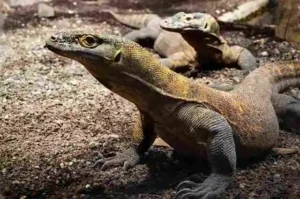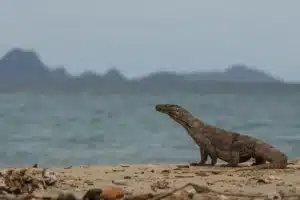Within the natural wealth of Indonesia, Komodos symbolize the uniqueness and captivating biodiversity that attracts worldwide attention. As the world’s largest lizard, the presence of Komodos adds a distinctive touch to the ecosystem of the islands around Nusa Tenggara. The Komodo National Park, with all its beauty and accompanying challenges, transforms into the last stronghold for this prehistoric species. The primary objective of these conservation efforts is to Protect Komodos from the growing threat of extinction.
The Komodo National Park, as the home of these prehistoric reptiles, faces serious challenges related to the preservation of the species and its habitat. The threats to Komodos and their environment stem not only from illegal hunting and climate change but also from the loss of their natural habitat due to land conversion and deforestation.
This article aims to highlight various aspects of conservation initiatives focused on Protect Komodos, encompassing a comprehensive understanding of biodiversity, preservation of natural habitats, conservation and restoration of populations, the development of sustainable ecotourism, and addressing future challenges. By prioritizing Komodos, these measures aim to ensure the continued survival of Komodos as an integral part of Indonesia’s unique natural heritage.
5 Conservation Initiatives to Protect Komodos
1. Diversity and Ecology of Komodo
source : agrotek.id
The Komodo dragon (Varanus komodoensis) is the world’s largest lizard naturally inhabiting islands around Nusa Tenggara. Biodiversity in Komodo National Park encompasses not only Komodo dragons but also several other endemic species integral to this ecosystem. Conservation efforts for Komodo require a holistic approach to protect and ensure its survival.
Conservation efforts involve a deep understanding of Komodo’s migration patterns, dietary needs, and interactions with other species in its ecosystem. Regular monitoring is crucial to identify changes and challenges faced by Komodo. Continuous scientific research provides further insights into Komodo’s behavior and ecology, forming a strong foundation for effective conservation strategies.
Conservation success relies not only on directly protecting Komodo but also on a profound understanding of their role in the unique ecosystem of Komodo National Park. Balancing the ecosystem and protecting all its inhabitants is the primary focus of this conservation effort. Engaging local communities, researchers, and other stakeholders can establish a robust framework for sustaining Komodo populations and biodiversity on these islands.
2. Threats to Komodo and Its Habitat
source : edumasterprivat.com
The main challenge in Protect Komodos is the threat to its natural habitat. Ongoing deforestation, rapid climate change, and illegal hunting are shrinking the living space of the Komodo dragon. Addressing these issues requires a deep awareness of the importance of maintaining ecosystem balance and understanding specific threats faced by Komodo.
In this context, government bodies, conservation agencies, and local communities collaborate to reduce pressure on Komodo’s habitat. Habitat protection measures involve establishing strong conservation areas, restoring lands damaged by human activities, and implementing strict surveillance on activities that may harm Komodo. Involving local communities in conservation efforts benefits not only Komodo but also creates sustainable involvement in maintaining ecosystem sustainability.
International support plays a crucial role in saving Komodo from habitat threats. International cooperation can strengthen conservation efforts, while educating local and international communities is essential to increase understanding of the need to preserve the environment. By addressing threats to its habitat holistically, these steps form a solid foundation for Protect Komodos and preserving wildlife in Komodo National Park.
3. Conservation and Population Recovery of Komodo
source : lampung.co
Conservation and population recovery of Komodo are the primary focus of conservation efforts. Breeding programs at conservation centers, monitoring births, and rehabilitating injured Komodo are concrete steps taken to protect Varanus komodoensis from increasing threats. Reintroducing Komodo to its natural habitat is considered crucial to ensuring genetic diversity and population sustainability, emphasizing the importance of preserving the unique ecosystem of Komodo National Park.
Active participation from local communities is a vital component of Komodo population conservation efforts. Educational programs, training, and raising awareness of Komodo’s critical role in maintaining ecosystem balance are integral parts of this conservation strategy. By involving communities directly, Komodo conservation efforts become a shared responsibility for both the government or conservation agencies and the community, ensuring environmental protection and Komodo preservation.
In this framework, involving local communities is not just as spectators but as key players in Komodo preservation. Broad support from the local community can strengthen the success of Komodo conservation efforts, ensuring that sustainability values and environmental protection are applied in everyday life. By embracing this active participation, we can build a stronger foundation for protecting Komodo and ensuring the sustainability of this species in the future.
4. Sustainable Ecotourism Development
source : kelloggsnyc.com
The development of sustainable ecotourism in Komodo National Park is not only a source of additional income but also a means to support conservation efforts and raise awareness of the need to Protect Komodos dragon. This approach requires the construction of environmentally friendly infrastructure, such as eco-friendly facilities and renewable energy, to minimize negative impacts on the island’s ecosystem.
Strict regulations on tourist activities are also crucial in ensuring the sustainability of Komodo National Park. Setting limits on the number of visitors and defined tourist routes can avoid excessive pressure on Komodo’s habitat and the surrounding environment. Wise management of visitor numbers will provide further protection for the sustainability of natural resources and the unique habitat of Komodo.
Through responsible ecotourism promotion, Komodo National Park can maintain a balance between economic benefits and environmental preservation. Support from private entities, international organizations, and environmentally conscious tourists is a key factor in ensuring that ecotourism has a positive impact on Komodo National Park. By combining economic interests and nature conservation, sustainable ecotourism development can become a successful model for protecting Komodo and preserving wildlife on this island.
5. Challenges and Hopes for the Future
source : freepik.com
Despite positive steps taken to Protect Komodos, challenges remain in the future. Unpredictable climate change, the release of invasive predators, and continuous pressure from human activities require sustained efforts to ensure the sustainability of Komodo National Park’s ecosystem. The hope for the future lies in strong commitments from all stakeholders, including governments, conservation agencies, local communities, and the international community, with a primary focus on protecting Komodo.
By maintaining positive momentum and fostering innovation in conservation efforts, we can ensure that Komodo remains an integral part of Indonesia’s natural heritage. Collective efforts must be continuously enhanced, considering ecosystem sustainability as the primary goal, so that Komodo can continue to thrive and dominate as an inspiring and protected species. The importance of raising awareness about the need to protect Komodo is not only a local responsibility but also a shared responsibility involving global participation.
Hopes for the future of Komodo National Park not only lie in the sustainability of its ecosystem but also in the secure and protected presence of Komodo as a unique and crucial species. Cross-border cooperation and joint contributions are needed to create an environment that supports Komodo’s life, allowing them to continue as guardians of the rich ecosystem in Indonesia. Through sustained attention and actions, we can ensure the preservation of this valuable natural heritage for future generations.
Conclusion
This article explores various aspects of conservation efforts implemented to Protect Komodos in Komodo National Park. Understanding biodiversity in this region is the foundation for designing effective strategies in the face of challenges this species encounters. A crucial step in preservation is addressing threats to Komodos, such as climate change, the release of invasive predators, and the ongoing impacts of human activities.
Conservation efforts also focus on preserving the Komodo population by identifying and implementing measures supporting natural reproduction and population growth. Additionally, the development of sustainable ecotourism in Komodo National Park is an important approach to supporting preservation while raising awareness of the importance of protecting Indonesia’s natural heritage.
While positive progress has been made in conservation efforts, this article emphasizes that addressing future challenges requires interdisciplinary collaboration. Involving all stakeholders, including the government, conservation organizations, the local community, and the international community, is the key to success in preserving Komodos and their ecosystem. With strong cooperation, we can create a greener and more sustainable future for Komodos, preserving Indonesia’s unique natural heritage. Visit Komodo National Park with Salut Bali we are ready to help you plan your activities on Komodo Island and be part of conservation efforts to Protect Komodos on Komodo Island.









